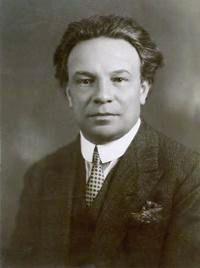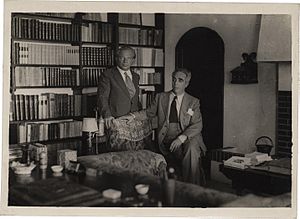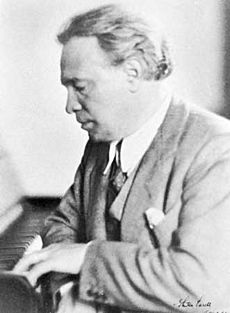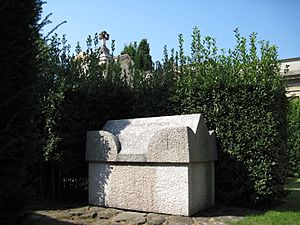Ottorino Respighi facts for kids
Ottorino Respighi (pronounced reh-SPEE-ghee) was an Italian composer, violinist, teacher, and music expert. He was one of Italy's most important composers in the early 1900s.
His music includes operas, ballets, and orchestral pieces. He also rewrote older music from the 16th, 17th, and 18th centuries, and even some works by Bach and Rachmaninoff.
Respighi is most famous for his three "Roman tone poems." These are orchestral pieces that paint pictures with music about Rome. They include Fountains of Rome (1916), Pines of Rome (1924), and Roman Festivals (1928). All three show off his amazing use of many different sounds and instruments in the orchestra.
Respighi was born and grew up in Bologna, Italy. He studied violin, viola, and composition there. He also worked in Saint Petersburg, Russia, and learned from the famous composer Nikolai Rimsky-Korsakov. In 1913, Respighi moved to Rome. There, he became a professor of composition at the Liceo Musicale di Santa Cecilia. Later, he left teaching to focus completely on writing music.
In early 1936, while working on his opera Lucrezia, Respighi became very ill. He died four months later at age 56. His wife, Elsa Respighi, lived for almost 60 more years. She worked hard to keep her husband's music and memory alive until she passed away in 1996.
About Ottorino Respighi
His Early Life
Ottorino Respighi was born on July 9, 1879, in Bologna. He was the youngest child of Giuseppe and Ersilia Respighi. His family had many artists. His mother's father and great-grandfather were famous sculptors. His father's father was a church organist.
Giuseppe, Ottorino's father, was a talented pianist and teacher. He taught his son piano and violin from a young age. At first, Ottorino wasn't very interested in music. But when he was almost eight, he started taking violin lessons. He even secretly learned to play a difficult piano piece by Robert Schumann. Respighi quickly learned other instruments too, like the harp, in just a few days!
Studying Music in Bologna
From 1890, Respighi went to school in Bologna. In 1891, he joined the Liceo Musicale di Bologna. For seven years, he studied violin and viola there. During this time, he wrote some of his first orchestral pieces.
Later, he started taking classes in music composition and music history. By the time he was 20, Respighi was playing violin in the orchestra at the Teatro Comunale di Bologna. His composition teacher, Giuseppe Martucci, was very important to him. In 1899, Respighi earned his diploma in violin playing. He also loved languages and learned to speak eleven of them!
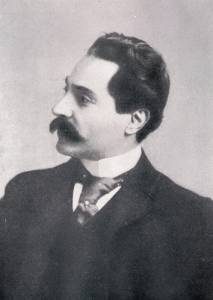
Learning from Rimsky-Korsakov
In the winter of 1900, Respighi became the main violist in an orchestra in Saint Petersburg, Russia. There, he met the famous Russian composer Nikolai Rimsky-Korsakov. Respighi greatly admired him and studied how to arrange music for orchestra for five months. He went back to Russia in 1902 for more lessons. These meetings greatly shaped how Respighi wrote his orchestral music.
Respighi finished his studies in Bologna in 1901. He wrote a piece called "Prelude, Chorale and Fugue" for his final exam. It was a big success! His teacher, Martucci, said: "Respighi is not a pupil, Respighi is a master."
Moving to Rome
In January 1913, Respighi moved from Bologna to Rome. He became a professor of composition at the Liceo Musicale di Santa Cecilia. He taught there for almost ten years. However, the busy city of Rome made it hard for him to compose and teach. He felt withdrawn and had trouble sleeping.
In 1915, another composer, Alfredo Casella, returned to Rome. He wanted to make Italian music more modern. Respighi had a small part in Casella's new music group. When Italy joined World War I in May 1915, Respighi was old enough to join the army. But his teaching job gave him a temporary break from military service.
Marriage and Famous Works
One of Respighi's new students was Elsa Olivieri-Sangiacomo. She was 14 years younger than him. They fell in love and got married in January 1919. Their friend, Claudio Guastalla, said their marriage was very harmonious.
In March 1916, Respighi's mother passed away. He was very sad and struggled for a while. But a big moment in his career happened on March 11, 1917. His first Roman tone poem, Fountains of Rome, was performed in Rome. The first time it was scheduled, the concert ended early because the audience disliked German music. Respighi was disappointed, but it made him want to write more.
Later, Respighi met the Russian ballet producer Sergei Diaghilev. Diaghilev wanted new ballets based on older music. Respighi helped by arranging piano pieces by Gioachino Rossini for a new ballet called La Boutique fantasque. This ballet was very successful. This also led Respighi to create his Ancient Airs and Dances, which are orchestral suites based on old Italian lute pieces.
Becoming Famous
A major event for Respighi happened when the famous conductor Arturo Toscanini asked him to perform Fountains of Rome in Milan in February 1918. The concert was a huge success! It made Respighi one of the most important Italian composers of his time.
In 1921, Respighi and Elsa started touring together, with Elsa performing as a concert artist. They traveled across Italy and to other countries like Prague and Vienna. Around this time, Respighi became good friends with the writer Claudio Guastalla. Guastalla encouraged him to write a new opera and offered to write the story for it. This led to Respighi's opera Belfagor. Guastalla would write the stories for all of Respighi's future operas.
In 1923, Respighi became the first director of the Conservatorio di Santa Cecilia in Rome. He didn't like the many administrative tasks this job required. So, in 1926, he resigned to spend more time composing. He continued to teach advanced composition classes until 1935.
Respighi's second Roman tone poem, Pines of Rome, was first performed in December 1924 in Rome. It became one of his most famous pieces.
Worldwide Recognition
By the mid-1920s, Respighi was famous around the world. He traveled a lot, conducting his own music or performing his piano pieces. He visited America for the first time in December 1925. He performed his piano and orchestral work, Concerto in modo misolidio, in Carnegie Hall in New York City.
In 1927, Respighi and Elsa went to Brazil. The music and culture there inspired him. He later wrote an orchestral work called Impressioni Brasiliane ("Brazilian Impressions"). In September 1927, Respighi conducted the first performance of his Trittico Botticelliano ("Botticelli Triptych"). This piece was inspired by three paintings by Sandro Botticelli.
In November 1928, Respighi returned to America for another premiere. By the end of that year, he had finished his third Roman tone poem, Roman Festivals. It took him only nine days to write! It was first performed in New York City in February 1929, with Arturo Toscanini conducting. After this, Respighi felt he had used all the orchestral sounds and colors he could. He then started writing more for smaller groups of instruments.
In 1929, Respighi arranged some piano pieces by Sergei Rachmaninoff for orchestra. Rachmaninoff was very happy with Respighi's work. In 1932, the Italian government gave Respighi a high honor, making him a member of the Royal Academy of Italy. From 1933 until his death, Respighi didn't complete any new compositions.
His opera La fiamma ("The Flame") was first performed in Rome in January 1934. In June 1934, Respighi and Elsa traveled to Argentina and Uruguay for concerts. Respighi's last completed work was an arrangement of an old piece called Didone.
By May 1935, Respighi had to cancel several concerts because he was not well. He was working on his next opera, Lucrezia, but his health got worse. He planned to work on another opera, but he couldn't finish it. Elsa, his wife, finished Lucrezia after he died, with the help of his former student Ennio Porrino.
His Death and Lasting Impact
In late 1935, Respighi became very ill with a fever and tiredness. In January 1936, doctors found a serious heart infection. At that time, there was no cure for it. Respighi's health got worse over the next four months. He died on April 18, 1936, in Rome, at age 56. Elsa and some friends were with him.
Elsa lived for almost 60 more years after her husband's death. She worked tirelessly to promote his music and legacy. She donated many of his unpublished writings and music to the Conservatorio G. B. Martini in Bologna, where he had studied. In 1969, she helped create a foundation to keep his letters and photos safe. Elsa also helped celebrate the 100th anniversary of Respighi's birth in 1979, even though some people tried to stop it. She said that some musicians with certain political views tried to make Respighi's music seem less important. But the celebration led to many of his forgotten works being performed and recorded. Elsa passed away in 1996, just before her 102nd birthday.
In 2000, a special plaque was placed in Bologna where Respighi was born. In 2006, an Italian conductor named Salvatore Di Vittorio was asked by Respighi's great-nieces to finish some of Respighi's incomplete music. This included a Violin Concerto from 1903, which was performed for the first time in 2010. Di Vittorio's orchestra continues to perform and record Respighi's music.
Ottorino Respighi's Music
Operas
- Re Enzo (1905)
- Semirâma (1909)
- Marie Victoire (finished in 1913, first performed in 2004)
- La bella dormente nel bosco (Sleeping Beauty) (1922)
- Belfagor (1923)
- La campana sommersa (The Sunken Bell) (1927)
- Maria egiziaca (Mary of Egypt) (1932)
- La fiamma (The Flame) (1934)
- Lucrezia (1937) (finished after his death by his wife, Elsa Respighi, and his student Ennio Porrino)
Ballets
- La Boutique fantasque (The Fantastic Toyshop) (1918), uses music by Gioachino Rossini.
- Sèvres de la vieille France (1920), arrangements of French music from the 1600s and 1700s.
- La Pentola magica (The Magic Pot) (1920), based on popular Russian tunes.
- Scherzo Veneziano (Le astuzie di Columbina) (1920)
- Belkis, Regina di Saba (Belkis, Queen of Sheba) (1932)
Orchestral Works
- Preludio, corale e fuga (Prelude, Chorale and Fugue) (1901)
- Aria per archi (Aria for Strings) (1901)
- Leggenda for Violin and Orchestra (1902)
- Piano Concerto in A minor (1902)
- Suite per archi (Suite for Strings) (1902)
- Humoreske for Violin and Orchestra (1903)
- Violin Concerto in A major (1903), finished by Salvatore Di Vittorio (2009)
- Fantasia Slava (Slavic Fantasy) (1903)
- Suite in E major (Symphony) (1903)
- Serenata per piccola orchestra (Serenade for Small Orchestra) (1904)
- Suite in Sol Maggiore (1905), for organ and strings
- Ouverture Burlesca (Burlesque Overture) (1906)
- Concerto all'antica for Violin and Orchestra (1908)
- Ouverture Carnevalesca (Carnival Overture) (1913)
- Tre Liriche (Three Lyrics) (1913), for mezzo-soprano and orchestra
- Sinfonia Drammatica (Dramatic Symphony) (1914)
- Fountains of Rome (1916)
- Ancient Airs and Dances Suite No. 1 (1917), based on old lute pieces.
- Ballata delle Gnomidi (Dance of the Gnomes) (1920)
- Adagio con variazioni (Adagio with Variations) (1921), for Cello and Orchestra
- Concerto Gregoriano for Violin and Orchestra (1921)
- Ancient Airs and Dances Suite No. 2 (1923), based on more old lute and viol pieces.
- Pines of Rome (1924)
- Concerto in modo misolidio (Concerto in the Mixolydian mode) (1925)
- Poema autunnale (Autumn Poem), for Violin and Orchestra (1925)
- Rossiniana (1925), based on pieces by Gioachino Rossini.
- Vetrate di chiesa (Church Windows) (1926), four movements.
- Trittico Botticelliano (Botticelli Triptych) (1927), inspired by Sandro Botticelli paintings.
- Impressioni brasiliane (Brazilian Impressions) (1928)
- The Birds (1928), based on Baroque pieces that sound like birds.
- Toccata for Piano and Orchestra (1928)
- Roman Festivals (1928)
- Metamorphoseon (1930)
- Ancient Airs and Dances Suite No. 3 (1932), arranged for strings only.
- Concerto a cinque (Concerto for Five) (1933), for oboe, trumpet, violin, double bass, piano and strings.
Vocal and Choral Music
- Nebbie (Fogs) (1906), for voice and piano
- Stornellatrice (The Ballad Singer) (1906), for voice and piano
- Cinque canti all'antica (Five Ancient Songs) (1906), for voice and piano
- Il Lamento di Arianna (Arianna's Lament) (1908), for mezzo-soprano and orchestra
- Aretusa (1911), a cantata for mezzo-soprano and orchestra
- Tre Liriche (Three Lyrics) (1913), for mezzo-soprano and orchestra
- La Sensitiva (The Sensitive Plant) (1914), for mezzo-soprano and orchestra
- Il Tramonto (The Sunset) (1914), for mezzo-soprano and string quartet or orchestra
- Cinque liriche (Five Lyrics) (1917), for voice and piano
- Quattro liriche (Four Lyrics) (1920), for voice and piano
- La Primavera (The Spring) (1922), a poem for singers, chorus and orchestra
- Deità silvane (Woodland Deities) (1925), songs for soprano and small orchestra
- Lauda per la Natività del Signore (Laud to the Nativity) (1930), a cantata for three soloists, mixed chorus, and chamber instruments.
Chamber Music
- String Quartet in D major (undated)
- String Quartet No. 1 in D major (1892–98)
- String Quartet No. 2 in B-flat major (1898)
- String Quartet in D major (1907)
- String Quartet in D minor (1909)
- Quartetto Dorico or Doric String Quartet (1924)
- Tre Preludi sopra melodie gregoriane (Three Preludes on Gregorian Melodies), for piano (1921)
- Violin Sonata in D minor (1897)
- Violin Sonata in B minor (1917)
- Piano Sonata in F minor
- Variazioni, for guitar
- Double Quartet in D minor (1901)
- Piano Quintet in F minor (1902)
- Six Pieces for Violin and Piano (1901–06)
- Quartet in D major for 4 Viols (1906)
- Huntingtower: Ballad for Band (1932)
- String Quintet for 2 Violins, 1 Viola & 2 Violoncellos in G minor (1901, incomplete)
Books
- Orpheus (1926)
Images for kids
See also
 In Spanish: Ottorino Respighi para niños
In Spanish: Ottorino Respighi para niños


